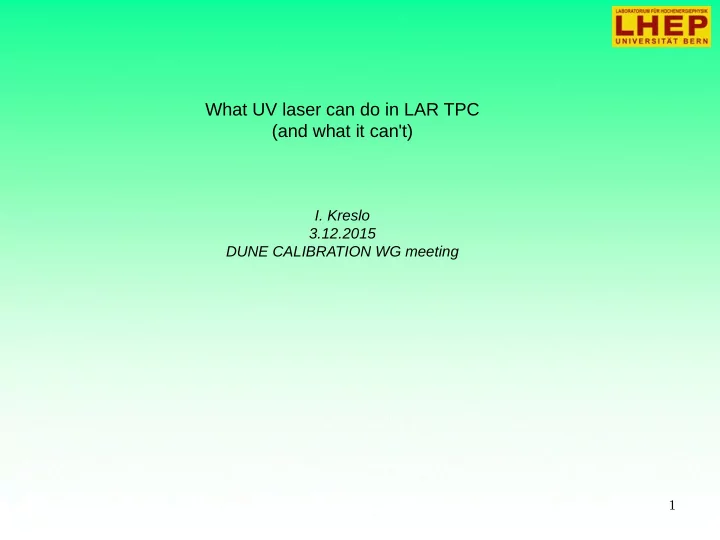

What UV laser can do in LAR TPC (and what it can't) I. Kreslo 3.12.2015 DUNE CALIBRATION WG meeting 1
Straight ionization tracks by UV pulsed laser A Prototype liquid Argon Time Projection Chamber for the study of UV laser multi-photonic ionization B. Rossi (Bern U., LHEP) et al.. Jun 2009. 26 pp. JINST 4 (2009) P07011 Measurement of the two-photon absorption cross-section of liquid argon with a time projection chamber I. Badhrees (Bern U., LHEP) et al.. Dec 2010. 16 pp. New J.Phys. 12 (2010) 113024 2
Effects contributing to the observable ionization 1. Beam divergence: nominal 0.5 mrad, can change at mirrors!) 2. Beam absorption: does not seem to be an issue... “Attenuation of vacuum ultraviolet light in liquid argon” A. Neumeier et al, Eur. Phys. J. C (2012) : λ att > 100 m at 266 nm 3. Rayleigh scattering 4. Refraction on density gradients 5. Non-linear effects (Kerr-induced self-focusing) 6. Charge amplifier response function 3
Rayleigh scattering at 266 nm Index of refraction, Rayleigh scattering length, and Sellmeier coecients in solid and liquid argon and xenon Emily Grace, James Nikkel, http://arxiv.org/pdf/1502.04213v1.pdf ( λ R ≈ 40m at 266 nm) 4
Non-linear effects (Kerr-induced self-focusing) AC Kerr effect: Self-focusing at beam power P > Pcr For silica, n 0 ≈ 1.453, n 2 ≈ 2.4×10 −20 m 2 /W,[12] and the critical power is Pcr ≈ 2.8 MW. @10 mJ per 5 ns pulse we are at P=2 MW ! To be calculated for LAR !! Is it self-focusing? Not 100% sure... 5
6 Straight ionisation tracks by UV pulsed laser Charge density → dE/dX Pulsed laser, t ~ 5 ns Charge attenuation → LAr purity F rep from 0 to 10 Hz Track curvature → Drift field 266 nm, ~10 mJ/pulse Track divergence → Tr. diffusion End peak → Lon. diffusion 2009 JINST 4 P07011 NJP 12 (2010) 113024 6
dE/dX calibration based on charge density Measurement of the two-photon absorption cross- section of liquid argon with a time projection chamber Multi-photon absorption: I. Badhrees (Bern U., LHEP) et al.. Dec 2010. 16 pp. New J.Phys. 12 (2010) 113024 N e n N 0 t =σ F − 56 cm ˙ 4 / s ,n = 2 t = 5 ns, σ= 1.2 10 − 19 J λ= 266 nm → 4.67 eV = 7.510 2 @ 1 mJ / 5 ns pulse,@beam 5 x 5 mm ; N e 24 ph − 17 e / atom F ≈ 10 = 510 2 s N 0 cm 21 atoms / cm ;dN e / dx = 2.610 5 e / cm N 0 / dx = 5.310 4 e / cm for MIP : dN e / dx ≈ 910 Systematic errors: 1. Charge life time (purity) 2. Beam divergence (0.5 mrad) 3. Rayleigh scattering 4. Preamp response 5. Refraction on gradients 6. Non-linear (self-focusing) 7
Charge attenuation measurement (ARGONTUBE data) Charge life time (purity) evolution Charge vs drift time LASER track Purification Systematic errors: 1. Beam divergence (0.5 mrad) Charge vs drift time muons 2. Rayleigh scattering 3. Refraction on gradients 4. Non-linear (self-focusing) 03/12/15 8 I. Kreslo for DUNE CALIBRATION WG meeting
ARGONTUBE geometry/field calibration with laser Laser track Before correction After correction Muon track Systematic errors: 1. V(E,T) dependence 2. Refraction on gradients 3. Non-linear (self-focusing) – so far didn't observe track deviation at charge blobs 03/12/15 9 I. Kreslo for DUNE CALIBRATION WG meeting
Expected improvement in coordinate accuracy (uBooNE example) 9 cm → O(mm) 10
MicroBooNE geometry/field calibration with laser 03/12/15 11 I. Kreslo for DUNE CALIBRATION WG meeting
Transverse diffusion (ARGONTUBE data) Laser ionisation track Systematic errors: 1. Charge life time (purity) 2. Beam divergence (0.5 mrad) 3. Rayleigh scattering 4. Refraction on gradients 5. Non-linear (self-focusing) 03/12/15 12 I. Kreslo for DUNE CALIBRATION WG meeting
Longitudinal diffusion (ARGONTUBE data) Track end: LASER-induced track Photoelectrons from cathode Cloud of photoelectrons 03/12/15 13 I. Kreslo for DUNE CALIBRATION WG meeting
Longitudinal diffusion (ARGONTUBE data) Systematic errors: PRELIMINARY 1. Amplifier response 2. Drift field uncertainty D L =3.8 ± 0.1 (stat.) +1.7 -0.9 (sys.) cm 2 /s 03/12/15 14 I. Kreslo for DUNE CALIBRATION WG meeting
Summary matrix for 40 m long beam dE/dx E drift Dt Dl Electron τ Beam XXX X X divergence Beam X X X absorption Rayleigh scattering X X X X (at>10m) Refraction on density X X gradient Non-linear effects (Kerr- X X XXX induced self- focusing) Preamp XXX X response 15
UV laser calibration system Conceptual design Goal: to provide straight ionisation tracks for field/purity calibration Tool: 4 UV lasers, each with steerable mirror feed-through 16
UV laser calibration system Primary beam generator Primary Source: Nd:YAG laser (Surelite I-10) from Continuum, Inc. with frequency multiplication: Output beam 266 nm , 60 mJ, 5 ns. Maximum repetition rate 10 Hz. Beam divergence 0.5 mrad Beam diameter about 5 mm 17
UV laser calibration system Rotating flange and steerable mirror 18
UV laser calibration system Cryostat and detector orientation Four steerable-mirror poles lowered from the cheminee top flange Beam 19
UV laser calibration system Cryostat and detector orientation Steerable optical FT Laser beams Beam 20
UV laser calibration system Entering TPC field cage Steerable mirrors Laser beams 21
Recommend
More recommend